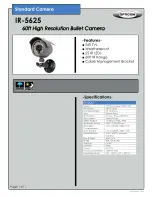
59
TS4000
7.0 Troubleshooting
CAUTION:
Component repair must be undertaken either by General Monitors personnel, or by
authorized service engineers. SMT PCB repair shall only be performed at a General Monitors
facility. Failure to comply with these requirements voids the product warranty.
NOTE:
Shutdown or disconnect all TS4000 external alarm wiring prior to conducting checks
that may cause the unit to enter an alarm condition.
7.1 Fault Codes and Remedies
The TS4000 has self-diagnostics incorporated into the microprocessor’s program. If a fault is
detected, the output signal drops to 0mA, the Fault relay de-energizes, and a Fault Code is
displayed.
Table 33 lists the ten fault conditions monitored by the TS4000, along with suggestions for
resolving these faults. If repeated attempts to resolve the faults are unsuccessful, return the
TS4000 to the factory or authorized service center for repair.
Table 33: Fault Codes
Fault
Code
Fault Type
Description
Action
F0
**
IM Communication
(1) IM does not communicate
(2) IM microprocessor has
Flash Data, Flash Code, or
RAM error
•
Verify that the BU and IM
are properly wired
F1
**
No Sensor
(1) No sensor is plugged into
the IM
(2) Non-functional Oxygen
sensor plugged into IM
•
Ensure sure that there is a
sensor plugged into the IM
•
Verify Oxygen sensor
functionality and replace if
necessary
F2
**
Calibration
Timeout
IM fails to complete
calibration within ten minutes
•
Remove gas, if present,
and recalibrate
•
If successive calibration
attempts fail, verify
calibration gas
•
If calibration gas verified,
replace sensor and
recalibrate
F3
**
Base Unit ROM
BU microprocessor controller
has a ROM error
•
Return the BU to the
factory or authorized
service center for repair
F4
**
Sensor Rate of
Change
Sensor reading has a high
rate of change (is not stable)
•
Wait until the sensor
reading stabilizes
•
Replace electrochemical
cell if fault persists















































